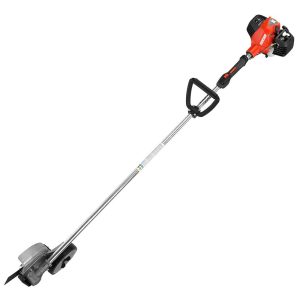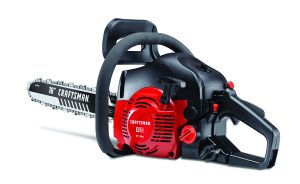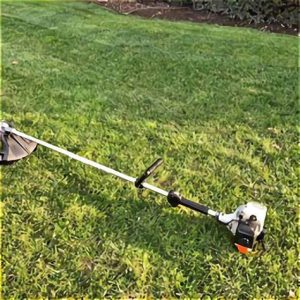13 Causes Of A RYOBI Chainsaw Not Starting: FIXED!
The majority of RYOBI chainsaw owners don’t use their tools every day. So it’s disappointing when your saw just won’t start when you actually need to use it. This might be the outcome of it hanging around with old gasoline, but it might also be the outcome of another factor.
A RYOBI chainsaw won’t start if the choke setting is off, the gasoline is old, the fuel filter is clogged, the carburetor is dirty, the fuel line is clogged, the air filter is clogged, the spark plug is faulty, the ignition coil is faulty, the primer bulb is faulty, the engine gets flooded, etc.
For a list of more items that could harm your RYOBI’s startup, continue reading. hile making repairs, use safety precautions, such as disconnecting the spark plug wire.

Table of Contents
The Causes Of A Ryobi Chainsaw Not Starting
Incorrect Choke Setting or Starting Technique for a Ryobi Chainsaw
On a Ryobi chainsaw, there is a choke lever. To start a cold engine, this lever must be in the fully choked position. Therefore, if you’re having trouble starting a cold engine without the choke, this might be the issue.
For a combustion to begin in a cold engine, a higher gas-to-air ratio is needed than in a warm engine. he choke needs to off and in the run position when starting an engine that has already warmed up.
Using a cold engine to start a Ryobi Chainsaw:
- About ten presses on the priming bulb will release gas into the carburetor.
- Set the choke lever so that it is fully choked.
- Till you hear the engine about to start, pull the starter cord. Don’t pull any further than this to avoid flooding the engine.
- Put the choke in the run position as soon as you hear the engine preparing to start.
- To restart the engine, tarter rope pulled back once more.
- So that the engine may continue to warm up, let the saw run for 15 to 30 seconds.
- y pushing the throttle release trigger, tightening the throttle trigger, and then releasing it, you can bring the saw back to idle.
Fuel in a RYOBI Chainsaw Is Old or Bad
When a chainsaw won’t start, especially after resting for a while, old gas is frequently the blame. Within 30 days of purchase, gas starts to degrade.
Most modern gas contains ethanol, which draws moisture. Over time, the varnish and clingy stains produced by his mixture of water and ethanol will block the flow of fuel, preventing the chainsaw from starting.
Gas needs to be used inside of 30 days. If you can’t use the gas up that quickly, stabilize it with an addition to fuel make it last a little bit longer.
Avoid gas with a high ethanol percentage, such as E15 and E85, which have ethanol contents of up to 15% and 85%, respectively. For more information on the gas to use with your particular chainsaw, go here.
If your car won’t start and you find that the fuel is stale, drain the tank and refill it.
A 2-cycle RYOBI chainsaw using the incorrect fuel
You don’t want to use the incorrect fuel for your RYOBI chainsaw.
A RYOBI chainsaw SHOULD NEVER BE FUELED WITH STRAIGHT GAS. It runs extremely dry and an absence of lubricant can lead to the engine seizing. Making n error like this might necessitate buying a new chainsaw.
RYOBI chainsaws powered by gas now need a 50:1 gas to oil ratio. One part of premium 2-cycle engine oil needs to be combined with fifty parts of unleaded gasoline.
ne fill port for an oil and gas container mixture is included on a Ryobi chainsaw. Combine superior 2-cycle engine oil that is approved by JASO M345 FD and ISO-L-EGD with fuel that is unleaded and has an octane value of 87 or higher.
The oil for 2-cycle engines is distinct from that for automobiles. DO NOT USE regular engine oil for automobiles.
gasoline free of ethanol
Using an ethanol-free fuel is optimal but more expensive because fuel with ethanol impairs the performance of your RYOBI chainsaw.
Despite being more expensive, it is a useful choice to keep on hand so you can avoid running to the gas station. You don’t need to take the time to measure and mix the gasoline.
You may get an excellent a product like the premixed fuel Tru-Fuel 50:1 online or at your neighborhood hardware shop.
Air Filter on a RYOBI Chainsaw Plugged
The RYOBI chainsaw’s air filter is crucial. This prevents sawdust and other debris from getting into the carburetor choke, which could otherwise cause wear and damage to engines.
Make that the air filter is in good working order. If it isn’t cleaned or changed on a regular basis, it might get so clogged that not enough air can move through it, which makes the chainsaw run slowly or won’t start.
The typical homeowner should change their air filter once a year and clean it frequently throughout the season. You will must more frequently clean and change the filter frequently if you use your chainsaw frequently.
Spend some time checking your air filter to avoid damaging engine overheating. Although it adds a step, checking the filter’s condition only takes a few seconds.
The filter has to be replaced if it is severely clogged or broken. A Chainsaw MUST ALWAYS HAVE AN AIR FILTER IN IT.
The below cleaning instructions apply to the majority of RYOBI chainsaw air filters. Consult the operator’s manual f you’re not sure what kind of filter you’re using or its cleaning recommendations.
Cleaning the FLEECE air filter on a RYOBI chainsaw:
- fter removing the filter and cleaning the air filter housing, shut the choke to prevent dirt from entering the carburetor.
- The air filter cover must be removed.
- Remove any debris and sawdust from the area surrounding the air filter.
- Take the air filter off.
- Either utilize pressurised air to expel interior air of the filter or knock dirt out of it. NEVER use a brush.
- If the filter is extremely unclean, wash it in a solution of water and a light dishwashing liquid, then rinse it from the inside out until the water is clear.
- Allow the filter to air dry fully. The filter should not be heated because doing so could harm it. AVOID rubbing oil on the filter.
- Clean filter reinstalled.
- If the old air filter is seriously broken or unclean, buy and install a new one.
- Put the cover back on.
RYOBI chainsaw with a bad spark plug
The spark needed to start and maintain a RYOBI chainsaw’s operation is provided by the spark plug. For the casual user, the spark plug is a worn component that should be replaced yearly.
Check the spark plug frequently, and between replacements, clean it with a wire brush. A filthy spark plug may misfire, which will affect the engine’s performance.
If a spark plug has an extremely dark tone and a charred electrode, or has porcelain broken, replace it.
Ensure that the spark plug is gapped in accordance with the manufacturer’s recommendations and that the spark plug wire is tightly fastened. Starting issues can also be brought on by these factors.
The RYOBI chainsaw’s ignition coil is defective
Check the ignition coil if you have a decent spark plug but are still not obtaining spark. The ignition coil’s winding may detach and short out.
The spark plug won’t receive the voltage necessary to produce a spark in this situation. This will result in issues with your chainsaw.
Detect a defective ignition coil by using an ohmmeter to look for continuity issues. If you discover a break, swap out the RYOBI ignition coil.
Fuel Filter Plugged in a RYOBI Chainsaw
On a RYOBI chainsaw, the fuel filter is situated across the fuel tank. A tiny cylinder-shaped component connected to the fuel line serves as the filter.
Before the fuel enters the fuel line, the filter strains it to keep out any dirt or debris. If the filter isn’t replaced on a regular basis, it may clog.
Not enough fuel will be able to pass through a clogged fuel filter. If enough fuel cannot reach the carburetor, your RYOBI might not start.
If you own a home who uses the saw occasionally or in emergency situations, I advise changing the fuel filter. You will need to replace the saw more frequently if you frequently use it to cut wood.
Chainsaw fuel filter replacement:
- When removing the fuel cap, wipe the area surrounding it to prevent any debris that might fall into the fuel tank.
- Taking off the gasoline cap (if you’ve recently used a chainsaw, let it cool down first).
- Hook the fuel line with a clean, bent wire, and then remove the fuel filter from the tank.
- While removing the filter from the gasoline line, hold the fuel line firmly. Hold onto the fuel line tightly.
- The male end of a new RYOBI fuel filter should be inserted into the fuel line and firmly fastened there before being installed.
- Reinstall the gasoline cap after placing the filter in the fuel tank.
A RYOBI chainsaw’s defective primer bulb
Fuel won’t properly flow into a damaged priming bulb won’t fill up with fuel, which prevents fuel from reaching the carburetor. Substitute a fresh priming bulb.
Fuel Line Clogged or Punctured on a RYOBI Chainsaw
The clogging of the gasoline line can result in a fuel restriction. This may make the RYOBI incapable of starting. Use carburetor cleaning to assist loosen the obstruction and ispatch the obstructed fuel line.
In order to eliminate the line, blow compressed air through it. It’s time to replace the fuel line with a new one if you are unable to clear the obstruction or if you discover that it is dry, broken, or punctured.
A RYOBI chainsaw’s dirty carburetor
The amount of fuel and air combined to ignite combustion in the cylinder is controlled by the carburetor. The carburetor will become clogged and gummed up with old fuel, preventing it from working as intended. Your chainsaw may be unable to start as a result.
You should be able to manage cleaning your carburetor if you have some mechanical aptitude. Take the carburetor apart, then clean it with carburetor cleanser.
After cleaning, if the carburetor still doesn’t work, you might need to rebuild it or get a new one.
A RYOBI chainsaw’s bad recoil starter
The engine of a RYOBI chainsaw is started by a recoil. Your recoil may not function due to a defective pulley, a missing spring, broken clips, or a loose spring.
You could try changing the spring and restringing the recoil. You would be better off just replacing the recoil assembly if it doesn’t work because other parts of your recoil, such the clips or the pulley, are broken.
Spark Arrestor on a RYOBI Chainsaw Plugged
The muffler’s spark arrestor is a tiny screen that can become blocked with soot. An airflow obstruction in a spark arrestor will prohibit a chainsaw from starting.
Remove the spark arrestor and use a wire brush to clean it. If you can’t sufficiently clean the spark arrester mesh screen or if it is broken, replace it.
Never operate a RYOBI chainsaw with a screen that is missing or damaged. In the absence of a screen, heated material from the saw could discharge, possibly igniting a fire or inflicting burns.
Engine Flooded on a RYOBI Chainsaw
When the choke is closed and the starter rope has been pulled repeatedly, the engine may flood.
It can also occur when the switch is off, the starter rope is pulled repeatedly, or the primer bulb is pushed excessively.
How to Restore a RYOBI Chainsaw’s Flooded Engine
When starting a flooded chainsaw, you can attempt a few of the following methods:
Option 1: Start a Flooded RYOBI Chainsaw
- Set the switch to the off/stop position.
- Clean the spark plug after removing it.
- The beginning rope should be pulled 6 to 8 times.
- The spark plug should now be installed again.
- In the start/on position, turn the switch.
- n the open/run position with the choke off, start the chainsaw.
Option 2: Start a Flooded RYOBI Chainsaw
- nsure that the choke is released and in the open-or-run position before turning the switch on.
- Pulling the starter rope repeatedly while depressing the throttle trigger. Starting this can require anywhere from 5 to 15 pulls. First, the chainsaw engine will splutter. It should start after pulling 2 to 3 more times.
Solutions To Ryobi Chainsaw Starting Issues
| Problems | Solutions |
|---|---|
| The Wrong Choke Setting Or A Bad witch | o limit airflow when starting an engine that is cold, make sure the choke is engaged. ollowing engine warming up, release the choke to let it keep running. Replace a faulty ground wire or switch. |
| Old Fuel | Fuel that is more than 30 days old should be replaced with new fuel. Fuel stabilizer should be added. |
| Incorrect Fuel | Remove the fuel. In chainsaws with 2-cycle engines, use a 50:1 gas and oil ratio. |
| Plugged Air Filter | A clogged air filter should be removed and cleaned. If the filter is seriously soiled, damp, or broken, get a new one. |
| Bad Spark Plug | Changing a damaged spark plug. Ensure the spark plug wire is properly installed and that the electrode gap is accurate. |
| Incorrect Ignition Coil | Change a damaged ignition coil. |
| Fuel Filter Clog | Install a new gasoline filter after removing the old one from the fuel tank. |
| Stupid Primer Bulb | |
| Fuel Line Blockage, Dryness, or Cracking | Remove the obstruction and a clogged fuel line. If the clog cannot be cleared or the gasoline line is dry or damaged, it must be replaced. |
| Dirty Carburetor | Clean the carburetor by removing it. Replace the broken components or rebuild the entire carburetor assembly. |
| Incorrect Recoil tarter | Restring the recoil starter and replace the spring. When the recoil starter is damaged, replace it. |
| Spark Arrestor Plugged | Take off the muffler’s spark arrestor. Install it once it has been cleaned with a wire brush. Replace a spark arrestor that is broken. |
| Flooded Chainsaw | Use one of the aforementioned solutions to get rid of the extra gasoline and start the chainsaw to fix this. |







